Persistent low-thorn gooseberry Altai numbered, guaranteeing a rich harvest of sweet berries
Altai numbered - a variety of low-thorn gooseberries, which are in high demand among summer residents. He is loved for the sweet taste of berries, unpretentious care and high frost resistance. We will tell you about the features of growing this variety, about what problems you can face and how to achieve good yield indicators.
The content of the article
What is this gooseberry variety
Altai numbered gooseberry is a medium early self-fertile variety, practically without thorns and suitable for breeding in different climatic conditions.
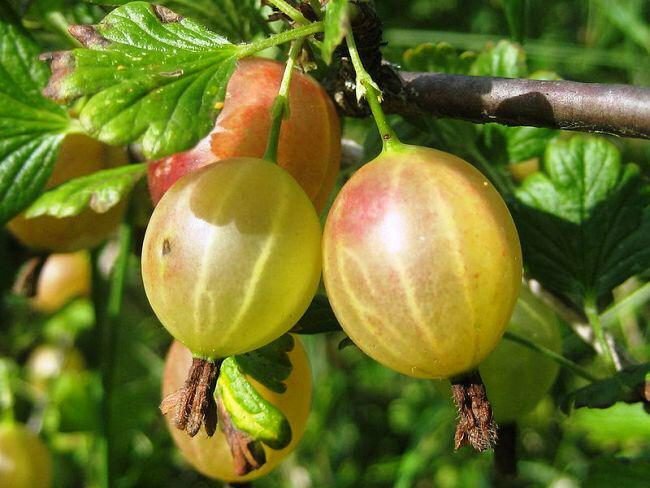
History of origin and distribution
The Altai license plate was obtained in 1978 thanks to the specialists of the South Ural Research Institute of Vegetable Growing. In 1987, after successfully passing the tests, the variety was added to the State Register.
The crop grows well in all regions of the country, but the highest yields were obtained in the Central Black Earth Region and the Moscow Region.
Characteristics and description of the bushes
The crown of the shrub is compact, slightly spreading, with straight shoots. The maximum height is about 1.5 m. There are few thorns, they are distributed along the entire length of the shoots and practically do not prick. The foliage is light green, small, three-lobed.
Resistant to temperatures
Altai license plate is resistant to temperature changes and does not suffer from frost even during the flowering period. It tolerates frosts down to -35 ° С, feels comfortable on hot days in the South of Russia, where the thermometer often rises to + 35 ... + 40 ° С.
Moisture and drought resistance
The yield of the variety does not decrease even in arid regions, but the Altai numbered room, like other varieties of gooseberries, does not like excess moisture. With stagnant water and too much watering, the root system of the bush begins to rot, which leads to the death of the plant.
Disease and pest resistance
Gardeners confirm that the variety rarely gets sick and is not afraid of most pests. They note good immunity to powdery mildew - the main gooseberry disease.
Characteristics and description of fruits

The first crop is harvested in the second or third year after landing, the variety enters the full fruiting phase at 4-6 years. 10-15 kg of rounded berries weighing up to 8 g are collected from each bush. The skin is dense, yellow with an amber tint. The berries remain firm even after full ripening and are juicy and sweet taste with a barely noticeable acidity.
Altai numbered self-fertile and does not need pollinating varieties. The first fruits ripen in mid-July, in the north - 2-3 weeks later.
Reference. The fruits of the Altai license plate must be collected immediately after they ripen, otherwise they will begin to crumble, and sunburn will form on the skin.
Application area
Thanks to a high tasting score of 5 points, the fruits of this variety are ideal for fresh consumption. Jams, compotes, confitures, liqueurs are also delicious.
Advantages and disadvantages of the variety
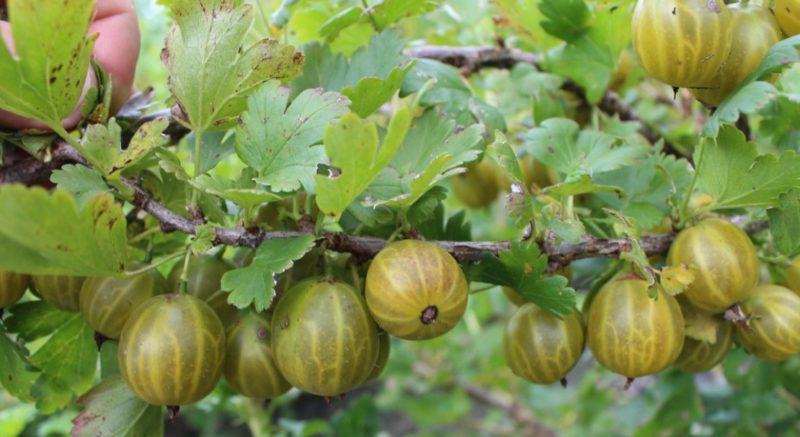
The Altai numbered gooseberry variety has a lot of advantages:
- high frost resistance;
- tolerates temperature changes well;
- unpretentious in care;
- has strong immunity;
- the crown is compact, slightly spreading;
- good yield indicators;
- excellent taste;
- easy to transport and stored for a long time.
Among the disadvantages of this gooseberry are:
- shedding of fruits;
- dense skin;
- the hardness of ripe berries.
Growing technology
In order for the bushes to grow well and bear fruit, it is important to follow the basic planting rules, as well as choose and prepare the right place.
Optimal conditions
Avoid shady and low-lying areas where moisture stagnation or groundwater levels higher than 1.5 m can form. Protect from wind and drafts, and do not plant bushes too close to each other so that the shoots do not intertwine.
Important! The soil should be fertile, with adequate aeration. Altai license plate loves loam and chernozem soil with neutral acidity, saturated with organic fertilizers.
Terms and rules of landing
Seedlings are placed in the ground in early spring or early October, so that the plant has time to acclimatize and take root. Before planting, the seedlings are recommended to be immersed for a couple of hours in a root growth stimulator, for example, Kornevin, in order to speed up the process of adaptation to new soil conditions.
Planting process:
- Prepare pits 50 × 50 cm. Keep a distance of 1.5 m between the bushes, and 2.5-3 m between the rows.
- Add organic and mineral fertilizers mixed with soil to each hole. For example, for every 1 sq. m 10 kg of humus mixed with 300 g of nitrophoska.
- Place the seedling, straightening the roots, and immerse the root collar no more than 5-7 cm.
- Fill the hole with soil in parts, carefully compacting each portion. Water immediately, using a bucket of water for each bush.
- Cover the soil with a thin layer of peat or humus to reduce the evaporation of moisture and avoid the appearance of a crust on the surface, which prevents the roots from receiving oxygen.
- If necessary, cut off the shoots, leaving 5-6 cm each with a small number of buds.
Further care
Altai license plate cannot be called whimsical. It is enough to follow the simple rules of care:
- Watering. The frequency and amount of moisture varies by region. In the northern regions, the bushes are watered every three weeks using 13-15 liters of water. In the center of the country, the interval is reduced to two weeks, pouring in 15-17 liters. In the southern regions, gooseberries are watered every 10 days using 20 liters of water.
- Loosening the soil... It is carried out after each watering so that the top layer does not turn into a crust, blocking access to oxygen for the roots. Weeds and debris are regularly removed - they can cause illness or pest infestations.
- Support. At a distance of half a meter from the bush, a stake or pipe is dug in, which are 50-70 cm higher than the gooseberry. The longest shoots are tied to the support, adding the rest as they grow.
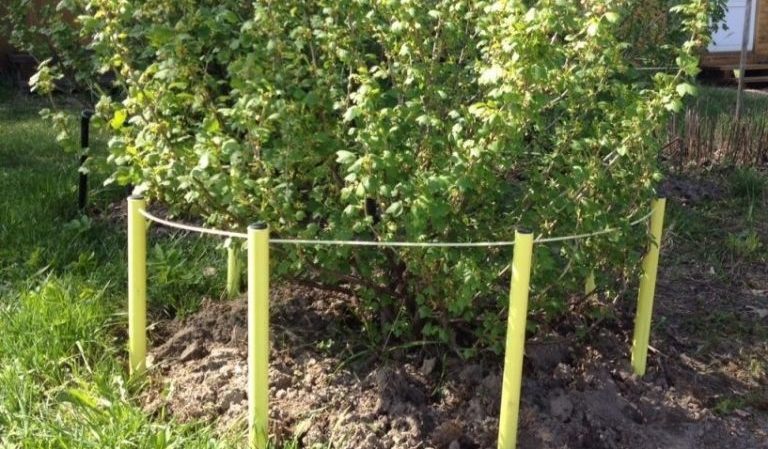
- Top dressing. In the spring, during the appearance of leaves, 5 liters of ammonium nitrate solution are poured under each bush (30 g per 7 liters of water). When forming ovaries use 10 liters of a solution of nitrophoska and urea (100 g of each substance). A couple of weeks before harvesting, 300 g of superphosphate is added under each bush.
- Pruning. In early spring, dry and diseased branches are pruned, increasing the immune defense of the shrub. Formative pruning can be carried out from the third year of life. It is carried out in early autumn, before the beginning of October, shortening all shoots by 30 cm. This stimulates the growth of new branches.
Don't worry if you had to skip watering. The variety is not afraid of drought and will patiently wait for the next irrigation.
Possible problems, diseases, pests
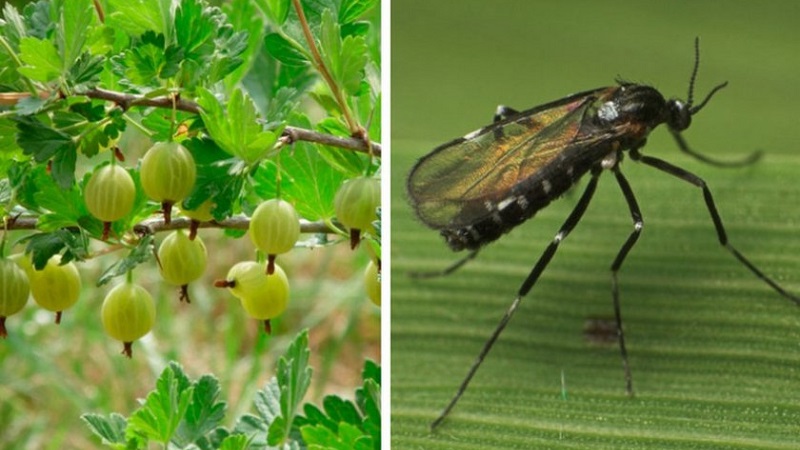
The variety has good immunity, but there are diseases that can harm the bushes:
- Rust (orange swellings on the leaves), which is eliminated by monthly treatment of the site with Bordeaux liquid: 100 g is diluted in 10 liters of water and the shrubs are sprayed 1-2 times a month, from March to the end of September. Such prevention minimizes the risk of rust formation. If the plant does get sick, the affected leaves are cut off and burned.
- Mosaic (yellow patterns along the main leaf veins), due to which the bush must be removed and burned.
- Anthracnose (brown spots on the leaves), requiring processing copper sulfate: 30 g of vitriol is diluted in 10 liters of water and the resulting liquid is sprayed on the bushes.
Of insects, aphids and caterpillars can harm the planting. They will be driven away by the treatment of bushes with a solution of wood ash (for 10 liters of water 200 g) or "Karbofos" (for 5 liters of water 50 g).
Wintering
For successful wintering, the trunk circle of each bush is covered with a 30 cm layer of fallen leaves, humus and straw, after pouring in a superphosphate solution (500 g per 10 l of water). In the south, special preparation is not required, but in a strong wind, the bush is covered with burlap, without pinching the crown.
Features of cultivation depending on the region
Gooseberry Altai license plate adapts well to various climatic conditions. The only peculiarity of its cultivation in the southern regions is that it is watered more often and more abundantly, and the harvest is harvested two weeks earlier than in other regions.
Reproduction
The variety is propagated in two ways: by layering and cuttings.
Breeding procedure by layering:
- In spring, young lower shoots are chosen (the age of the bush is no more than three years).
- The selected shoots are shortened by a third and pressed to the soil, sprinkling the area in the middle with earth. It is constantly watered and fertilized.
- In autumn, the layers are separated from the bush and planted in separate holes.
Propagation by cuttings:
- In early June, branches up to 10 cm long are cut from a young bush.
- The shoots are soaked in Kornevin solution for three days.
- They are planted in a greenhouse or nursery.
- After root formation, cuttings transplanted to a permanent place.
Reviews of summer residents
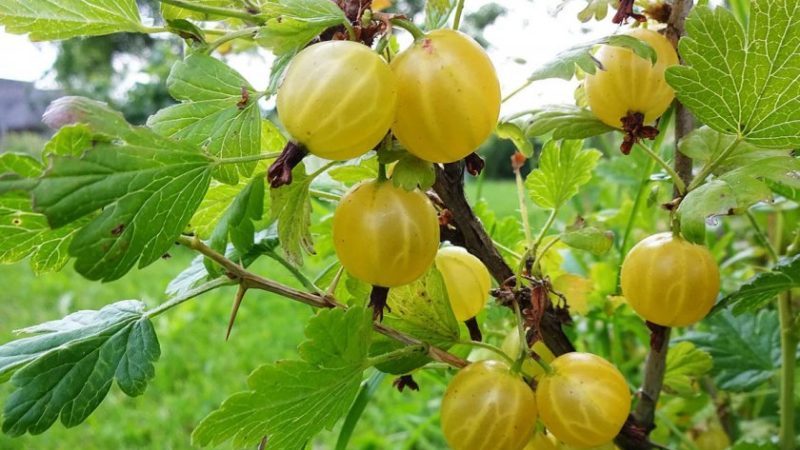
Gardeners speak favorably about this gooseberry variety, noting the unpretentiousness and sweet taste of the fruit.
Igor Cherkasov, Omsk: “The variety tolerates frosts and unexpected frosts remarkably well, it does not affect the yield in any way. There are few thorns, they do not interfere with picking berries. The fruit tastes sweet, without the characteristic acid, so we use it exclusively fresh. "
Roman Suslov, Ryazan: “The main rule is to harvest on time, otherwise the fruits will crumble and wither in the sun. The rest of the Altai numbered variety is very unpretentious, rarely gets sick, is not afraid of drought and frost and bears fruit abundantly. "
Conclusion
The Altai numbered gooseberry is one of the best representatives of its kind. It is distinguished by strong immunity, high fruiting rates and excellent berry taste. Suitable for growing in any climatic conditions and grows even among inexperienced summer residents.